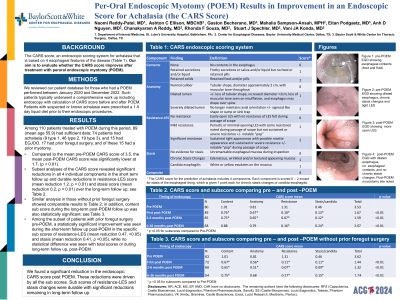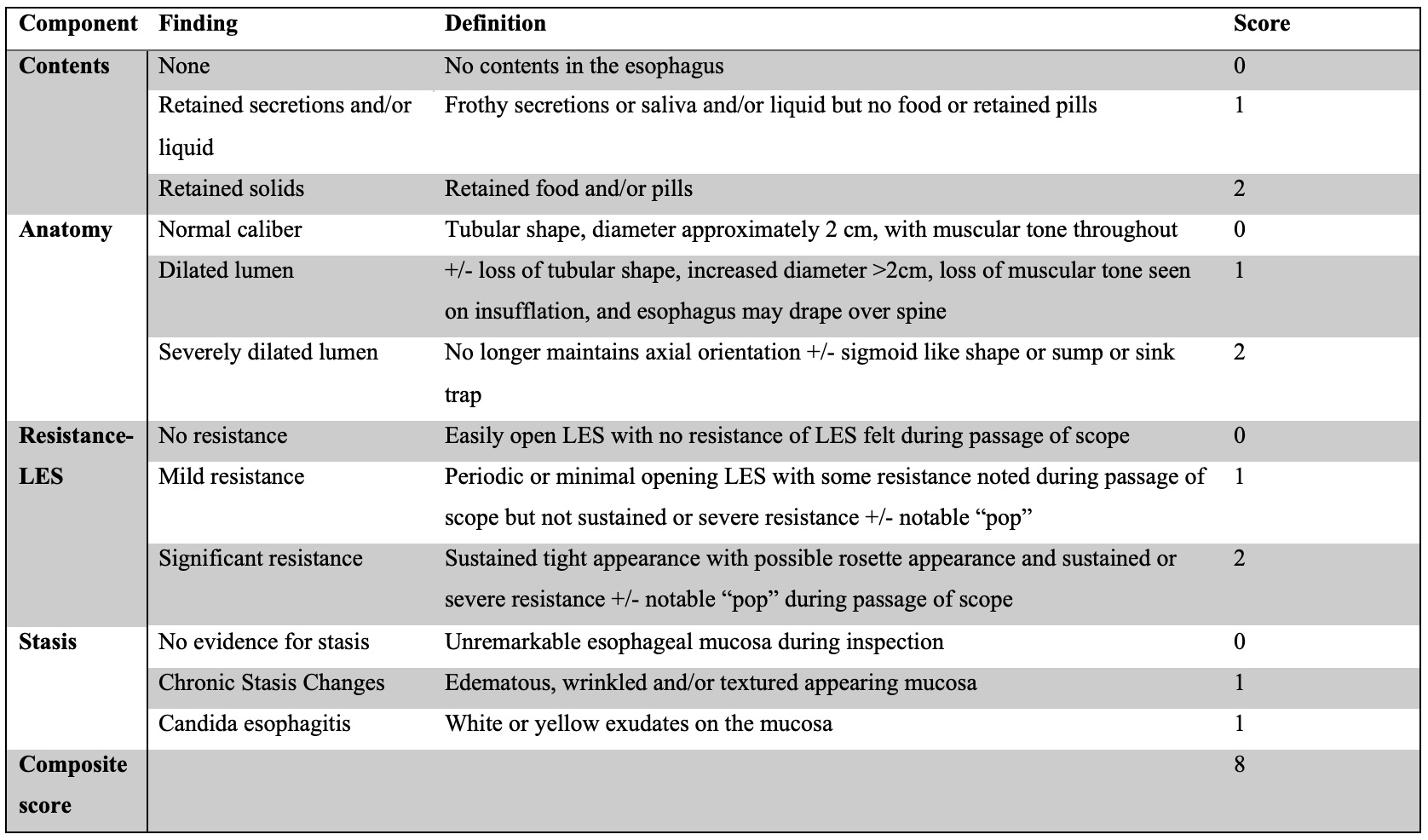Sunday Poster Session
Category: Esophagus
P0507 - Per-Oral Endoscopic Myotomy (POEM) Results in Improvement in an Endoscopic Score for Achalasia (the CARS Score)
Sunday, October 27, 2024
3:30 PM - 7:00 PM ET
Location: Exhibit Hall E

Has Audio

Naomi Reddy-Patel, MD
St. Luke's University Hospital
Bethlehem, PA
Presenting Author(s)
Naomi Reddy-Patel, MD1, Ashton C.. Ellison, MBChB2, Mahalia Sampson-Ansah, MPH2, Eitan Podgaetz, MD3, Anh D.. Nguyen, MD3, Chanakyaram A.. Reddy, MD3, Rhonda F.. Souza, MD4, Stuart J.. Spechler, MD5, Vani J.A.. Konda, MD5
1St. Luke's University Hospital, Bethlehem, PA; 2Center for Esophageal Diseases, Baylor University Medical Center, Dallas, TX; 3Center for Esophageal Diseases, Baylor Scott & White Medical Center, Dallas, TX; 4Baylor Scott & White Research Institute, Dallas, TX; 5Baylor University Medical Center and Center for Esophageal Research, Baylor Scott & White Research Institute, Dallas, TX
Introduction: We recently reported development of the CARS score, an endoscopic scoring system for achalasia that is based on abnormalities in 4 esophageal features of the disease (i.e., esophageal Contents, Anatomy, Resistance at the lower esophageal sphincter (LES), and Stasis) (Figure 1). We have shown that the CARS score performs well in predicting the presence of achalasia. Now, we aimed to find whether the CARS score improves after treatment with peroral endoscopic myotomy (POEM).
Methods: We reviewed our Center for Esophageal Diseases patient database for patients who had POEM for a disorder of outflow obstruction performed between January 2020 and December 2022 and continued care in our esophageal medical-surgical clinic. Such patients typically underwent a comprehensive work up including endoscopy with calculation of CARS score before POEM and a surveillance protocol including an endoscopy 3 months after POEM. Patients with suspected or known achalasia were prescribed a 1-5 day liquid diet prior to their endoscopic procedures.
Results: Among 96 patients treated with POEM during this time period, 66 (mean age 56.2, 55% female) had both pre- and post-POEM endoscopies; 56 patients had achalasia (8 type 1, 32 type 2, 16 type 3), and 10 had EGJOO. Median time to the first endoscopy after POEM was 3 months (IQR: 3-4). Compared to the mean pre-POEM CARS score (3.5, SD 1.8), the mean post-POEM CARS score was significantly lower (1.9, SD 1.4) (p < 0.01). Subset analyses of the 4 individual components of the CARS score revealed significant reductions in the Resistance-LES score (mean reduction 1.3, p < 0.01) and Stasis score (mean reduction 0.2, p = 0.01); see Table 1. Among the subset of patients with symptom scores post-POEM, a CARS score ≥4 during the short-term period had higher symptom scores in follow up, but this did not reach statistical significance (BEDQ 10 vs 3.6, NS; Eckhardt 4.1 vs 3.4, NS). Ongoing studies are examining CARS during a longer surveillance period.
Discussion: We found significant reductions in the endoscopic CARS score in patients treated with POEM. These reductions were driven primarily by improvements in the endoscopic assessment of Resistance-LES and Stasis changes. Further studies are needed to determine whether improvement in the CARS score can predict symptomatic improvement after POEM.

Note: The table for this abstract can be viewed in the ePoster Gallery section of the ACG 2024 ePoster Site or in The American Journal of Gastroenterology's abstract supplement issue, both of which will be available starting October 27, 2024.
Disclosures:
Naomi Reddy-Patel, MD1, Ashton C.. Ellison, MBChB2, Mahalia Sampson-Ansah, MPH2, Eitan Podgaetz, MD3, Anh D.. Nguyen, MD3, Chanakyaram A.. Reddy, MD3, Rhonda F.. Souza, MD4, Stuart J.. Spechler, MD5, Vani J.A.. Konda, MD5. P0507 - Per-Oral Endoscopic Myotomy (POEM) Results in Improvement in an Endoscopic Score for Achalasia (the CARS Score), ACG 2024 Annual Scientific Meeting Abstracts. Philadelphia, PA: American College of Gastroenterology.
1St. Luke's University Hospital, Bethlehem, PA; 2Center for Esophageal Diseases, Baylor University Medical Center, Dallas, TX; 3Center for Esophageal Diseases, Baylor Scott & White Medical Center, Dallas, TX; 4Baylor Scott & White Research Institute, Dallas, TX; 5Baylor University Medical Center and Center for Esophageal Research, Baylor Scott & White Research Institute, Dallas, TX
Introduction: We recently reported development of the CARS score, an endoscopic scoring system for achalasia that is based on abnormalities in 4 esophageal features of the disease (i.e., esophageal Contents, Anatomy, Resistance at the lower esophageal sphincter (LES), and Stasis) (Figure 1). We have shown that the CARS score performs well in predicting the presence of achalasia. Now, we aimed to find whether the CARS score improves after treatment with peroral endoscopic myotomy (POEM).
Methods: We reviewed our Center for Esophageal Diseases patient database for patients who had POEM for a disorder of outflow obstruction performed between January 2020 and December 2022 and continued care in our esophageal medical-surgical clinic. Such patients typically underwent a comprehensive work up including endoscopy with calculation of CARS score before POEM and a surveillance protocol including an endoscopy 3 months after POEM. Patients with suspected or known achalasia were prescribed a 1-5 day liquid diet prior to their endoscopic procedures.
Results: Among 96 patients treated with POEM during this time period, 66 (mean age 56.2, 55% female) had both pre- and post-POEM endoscopies; 56 patients had achalasia (8 type 1, 32 type 2, 16 type 3), and 10 had EGJOO. Median time to the first endoscopy after POEM was 3 months (IQR: 3-4). Compared to the mean pre-POEM CARS score (3.5, SD 1.8), the mean post-POEM CARS score was significantly lower (1.9, SD 1.4) (p < 0.01). Subset analyses of the 4 individual components of the CARS score revealed significant reductions in the Resistance-LES score (mean reduction 1.3, p < 0.01) and Stasis score (mean reduction 0.2, p = 0.01); see Table 1. Among the subset of patients with symptom scores post-POEM, a CARS score ≥4 during the short-term period had higher symptom scores in follow up, but this did not reach statistical significance (BEDQ 10 vs 3.6, NS; Eckhardt 4.1 vs 3.4, NS). Ongoing studies are examining CARS during a longer surveillance period.
Discussion: We found significant reductions in the endoscopic CARS score in patients treated with POEM. These reductions were driven primarily by improvements in the endoscopic assessment of Resistance-LES and Stasis changes. Further studies are needed to determine whether improvement in the CARS score can predict symptomatic improvement after POEM.

Figure: Figure 1: CARS endoscopic scoring system. The CARS score for the prediction of achalasia includes 4 components. Each component is scored 0 – 2 with the exception of stasis of the esophageal lining, which is given 1 point each for chronic stasis changes or candida esophagitis.
Note: The table for this abstract can be viewed in the ePoster Gallery section of the ACG 2024 ePoster Site or in The American Journal of Gastroenterology's abstract supplement issue, both of which will be available starting October 27, 2024.
Disclosures:
Naomi Reddy-Patel indicated no relevant financial relationships.
Ashton Ellison indicated no relevant financial relationships.
Mahalia Sampson-Ansah indicated no relevant financial relationships.
Eitan Podgaetz indicated no relevant financial relationships.
Anh Nguyen indicated no relevant financial relationships.
Chanakyaram Reddy indicated no relevant financial relationships.
Rhonda Souza: Capsulomics – Consultant. Castle Biosciences Inc – Consultant. Lucid Diagnostics – Consultant. Phathom Pharmaceuticals – Consultant. Sanofi – Grant/Research Support.
Stuart Spechler: Castle Biosciences – Consultant. Lucid Diagnostics – Consultant. Phathom Pharmaceuticals – Consultant. Takeda Pharmaceuticals – Consultant.
Vani Konda: Castle – Speakers Bureau. Exact – Advisory Committee/Board Member, Consultant. Medtronic – Advisory Committee/Board Member, Consultant. Pentax – Consultant. sebela – Advisor or Review Panel Member, Consultant.
Naomi Reddy-Patel, MD1, Ashton C.. Ellison, MBChB2, Mahalia Sampson-Ansah, MPH2, Eitan Podgaetz, MD3, Anh D.. Nguyen, MD3, Chanakyaram A.. Reddy, MD3, Rhonda F.. Souza, MD4, Stuart J.. Spechler, MD5, Vani J.A.. Konda, MD5. P0507 - Per-Oral Endoscopic Myotomy (POEM) Results in Improvement in an Endoscopic Score for Achalasia (the CARS Score), ACG 2024 Annual Scientific Meeting Abstracts. Philadelphia, PA: American College of Gastroenterology.
